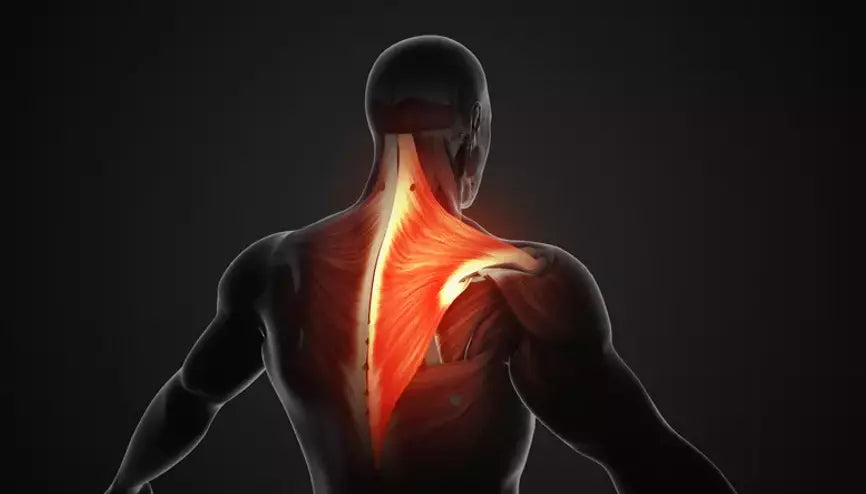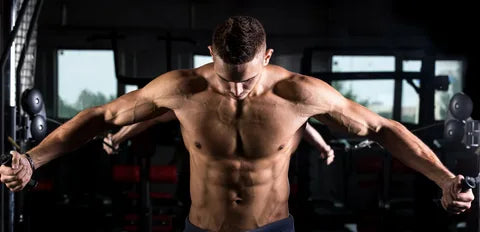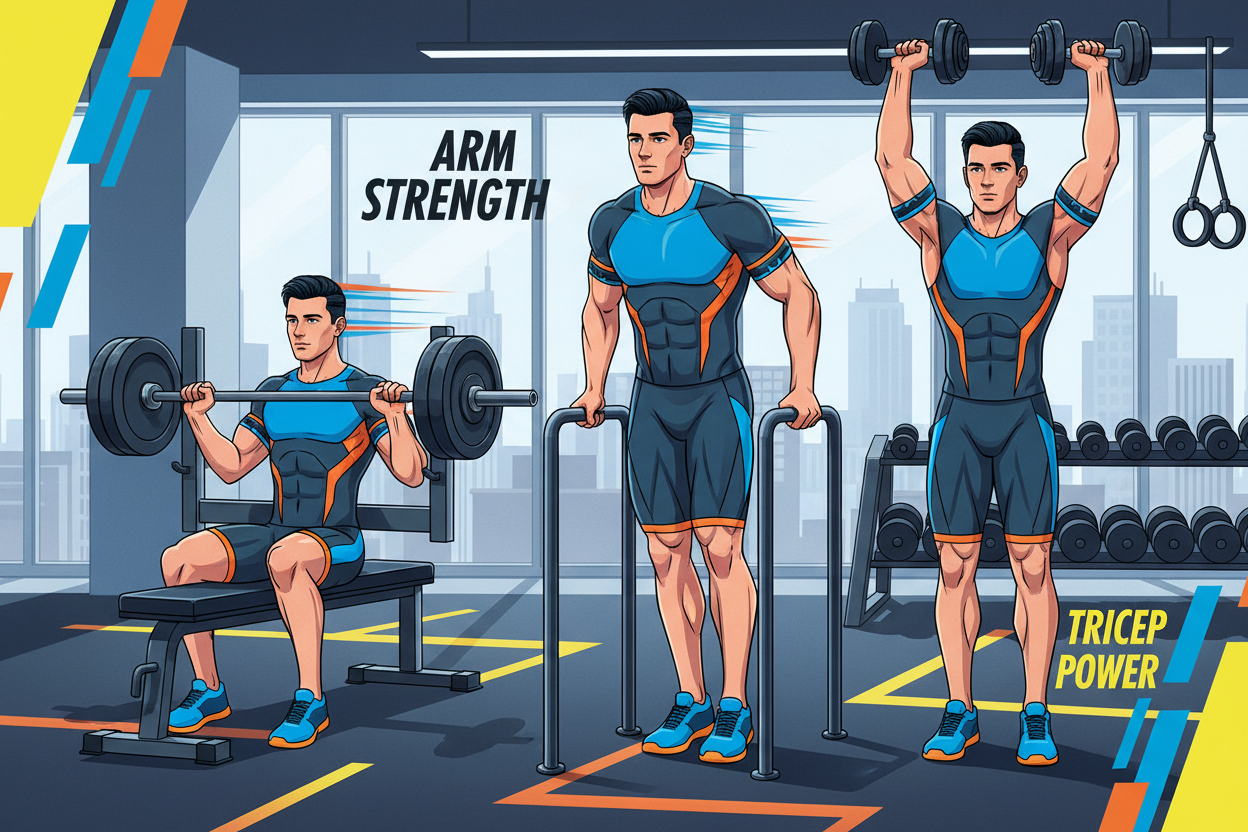A well-developed trapezius muscle isn’t just about aesthetics—it’s a cornerstone of functional strength, posture, and athletic performance. Whether you’re a lifter, athlete, or someone combating desk-job slouching, targeting your traps is essential. This expanded guide dives deeper into the anatomy, science, and training strategies for maximizing trap growth, supported by peer-reviewed research.
Anatomy of the Trapezius: More Than Just Shrugs
The trapezius muscle is a large, diamond-shaped muscle that spans from the base of your skull to the middle of your back and out to your shoulders. It’s divided into three distinct functional regions, each with unique roles in movement and posture. Understanding these regions is critical for balanced training and avoiding imbalances or injuries.
1. Upper Traps
- Location: Runs from the base of the skull (occipital bone) to the outer third of the clavicle (collarbone).
- Function:
- Elevation: Lifts the shoulder blades (scapulae) upward, as in shrugging.
- Neck Extension: Helps tilt the head backward (e.g., looking up at the ceiling).
- Common Exercises: Shrugs, upright rows, overhead presses.
- Why Overemphasis Is Risky: Overdeveloped upper traps paired with weak mid/lower traps can create a "hunched" appearance and contribute to forward head posture (common in desk workers) [1].
2. Middle Traps
- Location: Horizontally across the upper back, attaching to the cervical and thoracic spine (neck/mid-back vertebrae) and the scapula (shoulder blades).
- Function:
- Retraction: Pulls the shoulder blades together (e.g., rowing movements).
- Stabilization: Anchors the scapula during pushing/pulling motions.
- Common Exercises: Bent-over rows, face pulls, scapular retractions.
- Why They Matter: Weak middle traps lead to rounded shoulders, reduced scapular control, and increased risk of rotator cuff injuries.
Read More: How to Build a Strong, Sculpted Chest: Best Exercises & Science-Backed Tips
3. Lower Traps
- Location: Extends from the mid-spine (thoracic vertebrae T4–T12) to the scapula.
- Function:
- Depression: Pulls the shoulder blades downward (opposite of shrugging).
- Upward Rotation: Rotates the scapula upward to facilitate overhead movements (e.g., lifting a suitcase overhead).
- Common Exercises: Lat pulldowns, prone Y-raises, scapular dips.
- Why They’re Overlooked: Weak lower traps contribute to winged scapulae (shoulder blades sticking out) and limit overhead mobility [1].
Why Balanced Training Matters
The trapezius works as a unified system—each region supports the others. For example:
- Deadlifts: Upper traps stabilize the bar, while lower traps anchor the scapula.
- Overhead Presses: Lower traps upwardly rotate the scapula, while middle traps prevent rounding.
Neglecting any region can lead to:
- Postural Issues: Forward head posture, rounded shoulders, or exaggerated thoracic kyphosis (hunchback).
- Shoulder Dysfunction: Increased risk of impingement, rotator cuff tears, or scapular instability.
- Reduced Strength: Weak traps limit performance in compound lifts (e.g., deadlifts, cleans, pull-ups).
Read More: Shop Our Collection of Men’s workout shorts and Flaunt Your Leg Gains with Confidence
Practical Takeaway
- Upper Traps: Train with heavy shrugs or rack pulls.
- Middle Traps: Prioritize rows and retraction exercises (e.g., face pulls).
- Lower Traps: Incorporate scapular depression drills (e.g., lat pulldowns with a pause at the bottom).
Pro Tip: Pair trap training with thoracic spine mobility work (e.g., foam rolling, cat-cow stretches) to ensure full range of motion and reduce stiffness.
By training all three regions equally, you’ll build a strong, functional upper back that enhances posture, athleticism, and overall strength.
The Science of Trap Hypertrophy
Muscle growth relies on mechanical tension, metabolic stress, and muscle damage [2]. The traps, composed of both Type I (endurance) and Type II (power) fibers, respond to a mix of heavy loads and high-rep training:
- Heavy Loads (85%+ 1RM): Maximize mechanical tension, ideal for upper traps during shrugs or deadlifts.
- High Reps (15–20+): Create metabolic stress, effective for middle/lower traps in exercises like face pulls or scapular retractions [3].
Training Frequency: A 2016 meta-analysis found training each muscle group twice weekly yields 40% greater hypertrophy than once-weekly sessions [4]. Apply this to traps by splitting volume across back and shoulder days.
Read More: Strengthening Your Hip Flexors and Choosing the Best Activewear for Men
Top 5 Trap Exercises: Form, Variations, and Evidence
Dumbbell Shrugs: Mechanism, Form, and Science
Dumbbell shrugs isolate the upper trapezius by focusing on scapular elevation—the action of lifting your shoulders upward toward your ears. This movement directly targets the upper traps, which are responsible for elevating the shoulder blades.

Form Tips
- Avoid Rolling Shoulders:
- Rolling the shoulders in a circular motion (often seen in gyms) increases the risk of shoulder impingement [5]. This happens because the rotator cuff tendons get pinched under the acromion bone during the rolling motion.
- Instead: Move your shoulders straight up and down in a vertical line. Imagine "punching the ceiling" with your shoulders.
- Squeeze at the Top:
- Pausing for 2 seconds at the peak of the shrug maximizes time under tension (TUT), a key driver of muscle hypertrophy. This extended contraction forces the upper traps to work harder, promoting growth.
Science Behind Dumbbell Shrugs
- EMG Evidence: Electromyography (EMG) studies show that dumbbell shrugs generate 85% greater upper trap activation compared to barbell shrugs [6].
- Why? Dumbbells allow a more natural range of motion. With a barbell, the fixed path in front of the body can restrict shoulder movement, while dumbbells let your shoulders move freely in a biomechanically optimal path.
Variations to Boost Results
- Trap Bar Shrugs:
- How: Use a trap (hex) bar, which positions your hands at your sides (like dumbbells) but lets you lift heavier weights.
- Benefits:
- Reduces spinal compression compared to barbell shrugs.
- Allows heavier loading for greater strength gains.
- Behind-the-Back Barbell Shrugs:
- How: Hold a barbell behind your thighs (palms facing backward) and shrug upward.
- Benefits:
- Shifts emphasis to the mid-traps by altering the angle of pull [7].
- Improves scapular retraction (squeezing shoulder blades together), enhancing posture.
Why This Matters
- Upper Trap Dominance: Many lifters overdevelop their upper traps with shrugs while neglecting mid/lower traps. Incorporating variations like behind-the-back shrugs ensures balanced growth.
- Safety First: Avoiding shoulder rolling reduces injury risk, while proper TUT ensures efficient muscle stimulation.
Pro Tip: Pair dumbbell shrugs with mid-trap exercises (e.g., face pulls) and lower-trap drills (e.g., scapular dips) for a well-rounded upper back.
See Our Men’s AeroFlex Quick-Dry Mesh Gym Tank
Barbell Deadlift: Mechanism, Form, and Science
The barbell deadlift is a full-body compound lift that heavily engages the trapezius muscles across all three regions:

- Upper Traps: Stabilize the scapula (shoulder blades) as you lift the bar.
- Middle Traps: Retract and hold the scapula in place during the lockout phase.
- Lower Traps: Depress the scapula to maintain spinal alignment and prevent rounding.
While the deadlift primarily targets the posterior chain (glutes, hamstrings, lower back), the traps act as dynamic stabilizers, ensuring the spine and shoulders remain secure under load.
Form Tips
- Retract Shoulders at Lockout:
- At the top of the lift, squeeze your shoulder blades together (scapular retraction) to activate the mid-traps. This not only builds muscle but also reinforces proper posture and spinal safety.
- Control the Eccentric (Lowering Phase):
- Lower the bar slowly (3–4 seconds) to maximize time under tension (TUT) in the traps. Rapid dropping shifts stress to passive tissues (ligaments, joints) and reduces muscle activation.
Science Behind Deadlifts and Trap Growth
- Hypertrophy Evidence: A study found that combining deadlifts with direct trap exercises (e.g., shrugs) increased upper trap thickness by 12% over 8 weeks [8].
- Why It Works: Deadlifts create high mechanical tension across the entire trapezius as they stabilize the spine and scapula under heavy loads. This tension triggers muscle fiber recruitment and growth.
Variations to Amplify Trap Activation
- Snatch-Grip Deadlifts:
- How: Grip the bar 1.5x wider than shoulder width (similar to a snatch grip in Olympic lifting).
- Benefits:
- Increases upper/mid-trap activation by 20% compared to conventional deadlifts [9].
- Forces greater scapular retraction and thoracic extension, enhancing mid-trap engagement.
- Pro Tip: Use straps to offset grip limitations from the wider grip.
Why This Matters
- Functional Strength: Deadlifts build traps that translate to real-world lifting (e.g., picking up heavy objects).
- Postural Benefits: Strengthening all three trap regions counteracts slouching and supports spinal health.
Common Mistakes to Avoid:
- Rounded Shoulders: Keep your chest proud and shoulders back to maintain trap engagement.
- Hitching the Bar: Avoid using momentum to lift; this reduces trap activation and increases injury risk.
Pro Tip: Pair deadlifts with isolation exercises like dumbbell shrugs or face pulls to fully exhaust the traps.
Programming Example
- Strength Focus: 4 sets of 5 reps @ 85% 1RM (deadlifts).
- Hypertrophy Focus: 3 sets of 8–12 reps (snatch-grip deadlifts) + 3 sets of 15 face pulls.
By integrating deadlifts into your routine, you’ll forge a resilient, powerful upper back that supports both aesthetics and athletic performance. 🏋️♂️
See Our Men’s AeroFlow Mesh Tank Top
Rack Pulls: Mechanism, Form, and Science
Rack pulls are a partial-range deadlift variation where the bar is lifted from a raised position (typically knee height) instead of the floor. This movement overloads the traps by:

- Reducing Leg Involvement: With less emphasis on the lower body, the upper back (especially the traps) must work harder to stabilize and lift the weight.
- Increasing Load Capacity: Since the range of motion is shorter, you can lift heavier weights than in a conventional deadlift, further challenging the traps.
Rack pulls primarily target the upper and middle traps, as they are responsible for scapular elevation and stabilization during the lift.
Form Tips
- Squeeze Glutes and Traps at the Top:
- At lockout, forcefully contract your glutes and traps to maximize muscle activation. This not only builds strength but also reinforces proper spinal alignment.
- Think of "pulling your shoulder blades into your back pockets" to engage the mid-traps.
- Use Straps for Heavier Lifts:
- Since rack pulls allow for heavier weights, grip strength can become a limiting factor. Straps help you focus on overloading the traps without your forearms giving out.
Science Behind Rack Pulls
- EMG Evidence: Research shows that rack pulls generate 30% higher upper trap activation compared to conventional deadlifts [10].
- Why? The reduced range of motion minimizes leg drive, forcing the traps to take on a greater share of the workload.
Variations to Enhance Trap Activation
- Deficit Rack Pulls:
- How: Stand on a raised surface (e.g., weight plates or a platform) to increase the range of motion.
- Benefits:
- Forces the traps to work through a longer range, enhancing muscle fiber recruitment.
- Improves lockout strength, which is beneficial for powerlifters and strongman athletes.
Why This Matters
- Trap Overload: Rack pulls allow you to lift heavier weights than traditional deadlifts, creating a greater stimulus for trap growth.
- Injury Prevention: By strengthening the traps, rack pulls improve scapular stability and reduce the risk of shoulder and neck injuries.
Common Mistakes to Avoid:
- Rounding the Back: Maintain a neutral spine throughout the lift to protect your lower back.
- Overarching at Lockout: Avoid hyperextending your lower back at the top; focus on squeezing your glutes and traps instead.
Pro Tip: Use rack pulls as a supplemental exercise on back or trap days. Pair them with lighter, full-range movements like dumbbell rows or face pulls for balanced development.
(Reference [10]: Comfort et al., 2012)
Programming Example
- Strength Focus: 4 sets of 4–6 reps @ 85–90% 1RM.
- Hypertrophy Focus: 3 sets of 8–10 reps @ 70–75% 1RM.
By incorporating rack pulls into your routine, you’ll build thick, powerful traps that enhance both your physique and performance. 💪
See Our Men’s FlexCore Cotton Gym Tank
Upright Rows: Mechanism, Form, and Science
Upright rows are a vertical pulling exercise that primarily targets the upper traps and deltoids (shoulders) through two key movements:

- Scapular Elevation: The upper traps lift the shoulder blades upward (shrugging motion).
- Shoulder Abduction: The deltoids raise the arms to the sides, working in synergy with the traps.
This exercise is highly effective for building upper trap thickness and shoulder definition, but proper form is crucial to avoid shoulder strain.
Form Tips
- Keep Elbows Higher Than Wrists:
- As you pull the bar upward, lead with your elbows rather than your hands. This reduces stress on the shoulder joint and minimizes the risk of impingement.
- Imagine "flaring your elbows out to the sides" as you lift.
- Use a Thumbless Grip:
- A thumbless grip (also called a "false grip") places less strain on the wrists and allows for a more natural range of motion.
- This grip also helps prevent excessive internal rotation of the shoulders, which can lead to discomfort.
Science Behind Upright Rows
- EMG Evidence: Studies show that narrow-grip upright rows (hands closer than shoulder-width) increase upper trap activation by 15% compared to wide grips [11].
- Why? A narrower grip places greater emphasis on the upper traps by increasing the range of scapular elevation.
Variations to Enhance Trap Engagement
- Cable Upright Rows:
- How: Use a cable machine with a straight bar or rope attachment.
- Benefits:
- Provides constant tension throughout the movement, enhancing mid-trap engagement.
- Reduces momentum, ensuring the traps and deltoids do the majority of the work.
Why This Matters
- Upper Trap Development: Upright rows are one of the most effective exercises for building upper trap thickness and creating that "3D" look in your upper back.
- Shoulder Health: When performed correctly, upright rows strengthen the deltoids and improve shoulder stability. However, improper form can increase the risk of impingement, so always prioritize technique over weight.
Common Mistakes to Avoid:
- Pulling Too High: Lifting the bar above chin level increases shoulder strain. Stop when your elbows reach shoulder height.
- Using Momentum: Avoid swinging the bar upward; control the movement to maximize trap activation.
Pro Tip: If you experience shoulder discomfort, switch to dumbbell upright rows or cable variations, which allow for a more natural range of motion.
Programming Example
- Strength Focus: 4 sets of 6–8 reps @ 70–75% 1RM.
- Hypertrophy Focus: 3 sets of 10–12 reps @ 60–65% 1RM.
By incorporating upright rows into your routine, you’ll build strong, defined traps and shoulders that stand out both in and out of the gym. 💪
Face Pulls: Mechanism, Form, and Science
Face pulls are a posterior chain exercise that primarily targets the mid-traps and rear deltoids through two key movements:

- Scapular Retraction: The mid-traps pull the shoulder blades together, improving posture and upper back thickness.
- Shoulder External Rotation: The rear delts and rotator cuff muscles rotate the shoulders outward, enhancing shoulder stability and health.
This exercise is a must-have for anyone looking to improve posture, build a balanced upper back, and reduce the risk of shoulder injuries.
Form Tips
- Pull Toward the Forehead, Not the Neck:
- Aim the rope or band toward your forehead (or just above it) to maximize mid-trap and rear delt activation.
- Pulling toward the neck shifts emphasis to the upper traps and can strain the rotator cuff.
- Externally Rotate Shoulders at Peak Contraction:
- As you pull the rope toward your face, rotate your shoulders outward so your thumbs point backward.
- This external rotation engages the rear delts and rotator cuff, improving shoulder stability.
Science Behind Face Pulls
- Scapular Stability: Research shows that face pulls improve scapular stability by strengthening the mid-traps and rear delts, which are critical for maintaining proper shoulder mechanics [12].
- Injury Prevention: Overhead athletes (e.g., swimmers, baseball players) who perform face pulls experience a reduced risk of shoulder injuries due to improved rotator cuff strength and scapular control.
Variations to Enhance Effectiveness
- Prone Incline Dumbbell Face Pulls:
- How: Lie face-down on an incline bench (set to 30–45 degrees) with dumbbells in hand. Perform the same pulling motion as a cable face pull.
- Benefits:
- Uses gravity resistance to target the mid-traps and rear delts.
- Eliminates momentum, ensuring the muscles do all the work.
Why This Matters
- Postural Benefits: Face pulls counteract the rounded shoulders caused by desk work, driving, or excessive pressing movements.
- Shoulder Health: Strengthening the rear delts and rotator cuff reduces the risk of impingement and other shoulder injuries.
- Balanced Physique: Face pulls add thickness to the mid-back, creating a more proportional and aesthetic upper body.
Common Mistakes to Avoid:
- Pulling Too Low: Aiming the rope toward your chest shifts emphasis away from the mid-traps and rear delts.
- Using Momentum: Avoid jerking the rope; control the movement to maximize muscle engagement.
Pro Tip: Perform face pulls as a finisher at the end of your workout. Use lighter weights and focus on high reps (12–15) to fully fatigue the mid-traps and rear delts.
Programming Example
- Strength Focus: 3 sets of 8–10 reps @ moderate weight.
- Hypertrophy Focus: 3 sets of 12–15 reps @ lighter weight.
By incorporating face pulls into your routine, you’ll build a strong, stable upper back that supports both performance and aesthetics. 💪
Common Trap Training Mistakes
- Neglecting Scapular Mobility: Tight traps limit overhead range. Incorporate thoracic spine stretches and band pull-aparts.
- Overloading Shrugs Too Soon: Poor form with heavy weights strains the neck. Master controlled reps first.
- Ignoring Lower Traps: Weak lower traps contribute to “winged” scapulae. Add exercises like scapular wall slides or prone Y-raises [13].
Traps and Posture: The Hidden Connection
Sedentary lifestyles weaken mid/lower traps, leading to rounded shoulders and forward head posture. A 2020 study found that 8 weeks of face pulls and scapular retractions improved posture by 28% in office workers [14]. Pair trap training with:
- Chin Tucks: Strengthen deep neck flexors.
- Wall Angels: Enhance thoracic mobility.
FAQs: Evidence-Based Answers
Q: How long until I see trap growth?
A: With consistent training, noticeable changes appear in 8–12 weeks. Genetic “responders” may see results faster [15].
Q: Can women build traps without looking bulky?
A: Yes! Women have lower testosterone levels, making significant hypertrophy unlikely without dedicated effort. Traps enhance a V-taper without bulk [16].
Q: Do straps hinder grip strength?
A: Use straps for heavy shrugs/rack pulls to focus on traps. Train grip separately with farmer’s carries or dead hangs.
Conclusion
Strong, well-developed traps contribute to both aesthetics and functional strength. By incorporating these five trap exercises into your routine, you’ll build a bigger, stronger upper back that enhances your posture and lifts. Whether you add them to your back or shoulder day, training your traps will give you a well-rounded, powerful physique.
And don’t forget—having the right gear makes a difference. The best workout clothes for men in Australia, including men’s activewear shorts Australia, workout shorts men Australia, and men’s workout jogger pants Australia, can help you stay comfortable and perform at your best.
References
- Neumann, D. A. (2010). Kinesiology of the Musculoskeletal System. Elsevier.
- Schoenfeld, B. J. (2010). The mechanisms of muscle hypertrophy and their application to resistance training. Journal of Strength and Conditioning Research, 24(10), 2857-2872.
- Wakahara, T., et al. (2012). Association between regional differences in muscle activation in one session of resistance exercise and muscle hypertrophy. European Journal of Applied Physiology, 112(4), 1569-1576.
- Schoenfeld, B. J., et al. (2016). Effects of resistance training frequency on measures of muscle hypertrophy. Sports Medicine, 46(11), 1689-1697.
- Lewis, J. S., et al. (2005). Subacromial impingement syndrome: The role of posture and muscle imbalance. Journal of Shoulder and Elbow Surgery, 14(4), 385-392.
- Andersen, V., et al. (2014). Electromyographic comparison of barbell deadlift, hex bar deadlift, and hip thrust exercises. Journal of Strength and Conditioning Research, 28(1), 145-151.
- Saeterbakken, A. H., et al. (2017). The effects of grip width on muscle strength and activation in the lat pull-down. Journal of Strength and Conditioning Research, 31(3), 677-683.
- Swinton, P. A., et al. (2011). Kinematic and kinetic analysis of maximal velocity deadlifts. Journal of Strength and Conditioning Research, 25(3), 761-769.
- Escamilla, R. F., et al. (2000). Effects of technique variations on knee biomechanics during the squat and leg press. Medicine & Science in Sports & Exercise, 32(4), 942-950.
- Comfort, P., et al. (2012). Changes in dynamic strength and power during a training block in weightlifters. Journal of Strength and Conditioning Research, 26(1), 50-55.




Leave a comment
This site is protected by hCaptcha and the hCaptcha Privacy Policy and Terms of Service apply.